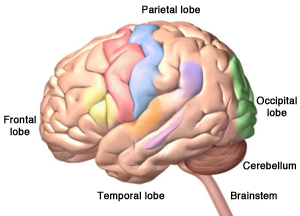Alzheimer’s disease isn’t the only cause of dementia. Unfortunately, there is no way to know for sure what type of dementia a person has. There is no blood test or x-ray that can diagnose Alzheimer’s or other types of dementia. The only sure way to know if someone had Alzheimer’s disease is to examine their brain after they die.
The symptoms are a little different in each type of dementia. It’s good to know the difference to help you understand why someone is acting the way they are.
Frontal-Temporal Dementia
Look at the picture of the brain below. Put your hands on your forehead. The part of your brain just behind your forehead is called the frontal lobe, you have one on each side of your forehead. Now slide your fingers from the front to the side of your head (your temple). This part of the brain is called the temporal lobe. You have two temporal lobes—one on each side.
There is a type of dementia that affects this part of the brain; it is called frontal-temporal dementia. It is the most common type of dementia in people under the age of 60. It’s not nearly as common as Alzheimer’s and it starts at a much younger age. Frontal-temporal dementia can affect one side of the brain or both.
Parts of the Brain

Copyright, Zygote Media Group, Inc. Used with permission.
We use the front part of our brain to make decisions, to tell right from wrong, and to control our emotions. We also use this part of the brain to plan for the future. People with dementia in this part of the brain have poor judgment and lose the ability to tell right from wrong. They also have less control over their behavior and have changes in personality.
In addition to behavioral changes, frontal-temporal dementia can affect a person’s language abilities. This is called aphasia and can cause difficulty understanding what another person is saying as well as difficulty with one’s own speech. A person’s speech might be hesitant, they may talk less that they did in the past, and they may have trouble naming things or understanding the meaning of words.
So, in the beginning, instead of difficulty with short-term memory like people with Alzheimer’s disease, a person with frontal-temporal dementia might start doing things that are confusing to their friends and family. They might steal, even though they have never stolen in the past. They might make inappropriate sexual remarks, swear, or engage in inappropriate sexual behaviors, even though they’ve never done these things in the past. Eventually, people with frontal-temporal dementia lose their short-term memory.
Vascular Dementia
Vascular dementia is caused by reduced blood flow to the brain from hardening of the arteries, small strokes, high blood pressure, infections, and certain auto-immune diseases. When blood flow is reduced, the brain is deprived of oxygen and nutrients. Generally, vascular dementia doesn’t affect memory as much as Alzheimer’s because damage is often spread throughout the brain. Depending on size and location, damage can be mild or severe and can affect more than one area of the brain.
Vascular dementia can cause mood swings, depression, irritability, and anxiety. It can also affect judgment—but usually not as strongly as in someone with frontal-temporal dementia. It is hard to say that vascular dementia leads to certain symptoms that are worse or less than other types of dementia because the symptoms tend to be strongly dependent on where the strokes have occurred.
You might have cared for more than one patient with vascular dementia because many older adults have high blood pressure that isn’t under good control. You may also see vascular dementia in someone who has had a stroke.
Lewy Body Dementia
Lewy body dementia is less common than Alzheimer’s dementia, frontal-temporal dementia, or vascular dementia. It is responsible for a little less than 5% of all cases of dementia. People with Parkinson’s disease can have this type of dementia.
In Lewy body dementia, abnormal clumps of alpha-synuclein (Lewy bodies) are scattered throughout the cortex, brainstem, and midbrain. The location of these clumps influences the symptoms, which vary from person to person.
People with Lewy body dementia may have problems with memory, which can be mistaken for Alzheimer’s disease. They may have movement difficulties that are similar to Parkinson’s disease (slow movement, tremors, difficulty walking). They can also have visual hallucinations, mental fluctuations (drowsiness, staring into space, long naps, disorganized speech), and sudden confusion. These symptoms may come and go throughout the day.
People with Lewy body dementia can also experience visuospatial difficulties. This is more than just visual difficulties—they can have problems processing where objects are in space, including their own arms and legs. Other visuospatial difficulties include trouble with depth perception, judging distance, and understanding the distance between two objects. It also involves difficulties with math and reading. We use visuospatial skills to dance, make sense of the shape of numbers and letters, and to keep from bumping into someone passing us in the hallway.
Lewy body dementia can also affect a person’s sleep and cause a person to suddenly faint or pass out. This means a person with Lewy Body dementia is at high risk for unexpected falls.
Dementia’s Characteristics and Symptoms | |
|---|---|
Type of dementia | Characteristics and symptoms |
Alzheimer’s disease (AD) | Loss of short-term memory Behavioral changes, apathy, depression, anxiety Personality and behavior changes Mood swings Difficulty communicating and understanding speech |
Frontal-temporal dementia | Changes in behavior Poor judgment Loss of moral reasoning Loss of inhibition Changes in speech and communication |
Vascular dementia | Memory affected but less than in AD Poor judgment Mood changes—more than in AD Apathy Irritability |
Dementia with Lewy bodies | Visual hallucinations Sleep disturbance Motor control problems Mental fluctuations Visuospatial difficulties |
